Djong (ship)
The djong, jong, or jung (also called junk in English) is a type of ancient sailing ship originating from Java that was widely used by Javanese and Malay sailors. The word was and is spelled jong in its languages of origin, the "djong" spelling being the colonial Dutch romanisation.[1]
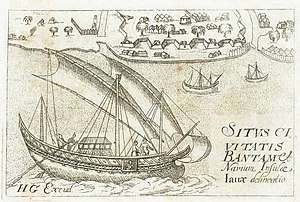
Djongs are used mainly as seagoing passenger and cargo vessels. They traveled as far as Ghana or even Brazil in ancient times.[2] The average burthen was 400-500 deadweight tons[note 1], with a range of 85-2000 tons. In the Majapahit era these vessels were used as warships, but still predominantly as transport vessels.[3]:308[4]
Etymology
Views diverge on whether the origin of the word is from a dialect of Chinese, or from a Javanese word. The word jong, jung or junk may derives from the Chinese word for boat (船),[5][6] originally pronounced ɦljon in Old Chinese. However, Paul Pelliot and Waruno Mahdi rejects the Chinese origin for the name.[7][8]:38 The word jong can be found in a number of ancient Javanese inscriptions dating to the 9th century.[9][10] It was first recorded in the Malay and Chinese language by the 15th century, when a Chinese word list identified it as a Malay term for ship,[11] thus practically excludes the Chinese origin of the word.[9] The late 15th century Malay Maritime Laws uses jong frequently as the word for freight ships.[11] European writings from 1345 through 1601 use a variety of related terms, including jonque (French), ioncque (Italian), iuncque, joanga, juanga (Spanish), and ionco, djonk, jonk (Dutch).[12]
The origin of the word "junk" in English language, can be traced to Potuguese word junco, which is rendered from Arabic word j-n-k (جنك). This word comes from the fact that Arabic script cannot represent the digraph "ng".[8]:37 The word used to denote both Javanese/Malay ship (jong) and Chinese ship (chuán), eventhough the two were markedly different vessel. After the disappearance of jong in the 17th century, the meaning of "junk" (and other similar words in European languages), which until then was used as a transcription of the word "jong" in Malay and Javanese, changed its meaning to exclusively Chinese ship only.[13][8]:222
People from the Nusantara archipelago usually refer to large Chinese ships as "wangkang", while small ones are called "top".[14] There are also terms in the Malay language, "cunea", "cunia", and "cunya" that originates from the Amoy Chinese dialect 船 仔 (tsûn-á), which refers to Chinese vessels 10-20 m in length.[15][16] The "djong" spelling is of colonial Dutch origin, rendering the j sound as "dj", though both traditional British and current Indonesian orthography romanises it as jong.[1]
Sailor and navigation
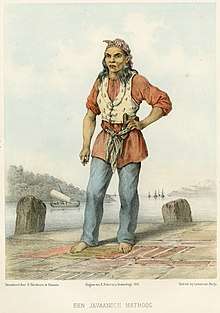
The Nusantara archipelago was known for production of large junks. When Portuguese sailors reached the waters of Southeast Asia in the early 1500s they found this area dominated by Javanese junk ships. This Javanese trading ship controlled the vital spice route, between Moluccas, Java and Malacca. The port city of Malacca at that time practically became a Javanese city. There were many Javanese merchants and ship captains who settled and at the same time controlled international trade. Many skilled Javanese carpenters are building ships in the dockyards of the largest port city in Southeast Asia.[11]
For seafaring, the Malay people independently invented junk sails, made from woven mats reinforced with bamboo, at least several hundred years before 1 BC. By the time of the Han dynasty (206 BC to 220 AD) the Chinese were using such sails, having learned it from Malay sailors visiting their Southern coast. Beside this type of sail, they also made balance lugsails (tanja sails). The invention of these types of sail made sailing around the western coast of Africa possible, because of their ability to sail against the wind.[17][18]
During the Majapahit era, almost all of the commodities from Asia were found in Java. This is because of extensive shipping by the Majapahit empire using various type of ships, particularly the jong, for trading to faraway places.[3]:267–293 Ma Huan (Zheng He's translator) who visited Java in 1413, stated that ports in Java were trading goods and offer services that were more numerous and more complete than other ports in Southeast Asia.[3]:241 It was also during Majapahit era that Nusantaran exploration reached its greatest accomplishment. Ludovico di Varthema (1470-1517), in his book Itinerario de Ludouico de Varthema Bolognese stated that the Southern Javanese people sailed to "far Southern lands" up to the point they arrived at an island where a day only lasted four hours long and was "colder than in any part of the world". Modern studies have determined that such place is located at least 900 nautical miles (1666 km) south of the southernmost point of Tasmania.[19]
The Javanese and Malay people, like other Austronesian ethnicities, use a solid navigation system: Orientation at sea is carried out using a variety of different natural signs, and by using a very distinctive astronomy technique called "star path navigation". Basically, the navigators determine the bow of the ship to the islands that are recognized by using the position of rising and setting of certain stars above the horizon.[20]:10 In the Majapahit era, compasses and magnets were used, and cartography (mapping science) was developed: The use of maps full of longitudinal and transverse lines, rhumb lines, and direct route lines traveled by ships were recorded by Europeans, to the point that the Portuguese considered the Javanese maps were the best map in the early 1500s.[19][21]
When Afonso de Albuquerque conquered Malacca, the Portuguese recovered a chart from a Javanese pilot, which already included part of the Americas. Regarding the chart Albuquerque said:[2]
"...a large map of a Javanese pilot, containing the Cape of Good Hope, Portugal and the land of Brazil, the Red Sea and the Sea of Persia, the Clove Islands, the navigation of the Chinese and the Gom, with their rhumbs and direct routes followed by the ships, and the hinterland, and how the kingdoms border on each other. It seems to me. Sir, that this was the best thing I have ever seen, and Your Highness will be very pleased to see it; it had the names in Javanese writing, but I had with me a Javanese who could read and write. I send this piece to Your Highness, which Francisco Rodrigues traced from the other, in which Your Highness can truly see where the Chinese and Gores come from, and the course your ships must take to the Clove Islands, and where the gold mines lie, and the islands of Java and Banda, of actions of the period, than any of his contemporaries; and it appears highly probable, that what he has related is substantially true: but there is also reason to believe that he composed his work from recollection, after his return to Europe, and he may not have been scrupulous in supplying from a fertile imagination the unavoidable failures of a memory, however richly stored." - Letter of Albuquerque to King Manuel I of Portugal, April 1512.
A Portuguese account described how the Javanese people already had advanced seafaring skills when they arrived:[22]
(The Javanese) are all men very experienced in the art of navigation, to the point that they claim to be the most ancient of all, although many others give this honor to the Chinese, and affirm that this art was handed on from them to the Javanese. But it is certain that they formerly navigated to the Cape of Good Hope and were in communication with the east coast of the island of San Laurenzo (Madagascar), where there are many brown and Javanized natives who say they are descended from them.
— Diogo de Couto, Decada Quarta da Asia
Description
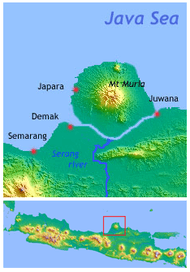
Duarte Barbosa reported that the ships from Java, which have four masts, are very different from Portuguese ships. A Javanese ship is made of very thick wood, and as it gets old, the Javanese fix it with new planks, this way they have 3-4 planks, one above other. The rope and the sail is made with woven rattan.[23] The Javanese junks were made using jaty/jati wood (teak) at the time of his report (1512), at that time Chinese junks were still using softwood as their main material.[24] The Javanese ship's hull is formed by joining planks to the keel and then to each other by wooden dowels, without using either a frame (except for subsequent reinforcement), nor any iron bolts or nails. The planks are perforated by an auger and inserted with dowels, which remains inside the fastened planks, not seen from the outside.[25] On some of the smaller vessels parts may be lashed together with vegetable fibers.[17] The vessel was similarly pointed at both ends, and carried two oar-like rudders and lateen-rigged sails (actually tanja sail)[note 2], but it may also use junk sail, a sail of Malay origin.[18] It differed markedly from the Chinese vessel, which had its hull fastened by strakes and iron nails to a frame and to structurally essential bulkheads which divided the cargo space. The Chinese vessel had a single rudder on a transom stern, and (except in Fujian and Guangdong) they had flat bottoms without keels.[11]

Historical engravings also depict usage of bowsprits and bowsprit sails, with deckhouse above the upper deck, and the appearance of stemposts and sternposts.[27] The deckhouse is extending from the front to the back, where people are protected from the heat of the sun, rain, and dew. At the stern there is a cabin for the ship's captain.[28] This cabin, is square in shape and protruding ("hanging") above the sharp waterline stern (the sternpost). The bow also has square platform that protrude above the stempost, for bowsprit and forward facing gun shield/gun mount (apilan or ampilan in Malay language).[29][14] A jong could carry up to 100 berço (breech loading artillery - likely refers to local cetbang cannon).[30] According to father Nicolau Pereira, the jong has 3 rudders, one on each side and one in the middle. Pereira's account is unusual, however, because other accounts only mention 2 quarter rudders. This may refer to hybrid jong, with middle rudder being like those on Chinese vessels (hanging axial rudder) or western axial rudder (pintle and gudgeon rudder).[25] A jong has about 1:3 to 1:4 beam to length ratio,[3]:292 which makes it fell to the category of "round ship".[4]:148 and 169[31]
Barbosa also reported various goods carried by these ships, which include rice, meat of cows, sheep, pigs, and deer, dried and salted, many chickens, garlic, and onions. Traded weapons include lances, dagger, and swords, worked in inlaid metal and very good steel. Also brought with them cubebs and yellow die called cazumba (kasumba) and gold which is produced in Java. Barbosa mention places and route in which these ships visited, which include Malacca, China, Molucca Islands, Sumatra, Tenasserim, Pegu, Bengal, Palicat, Coromandel, Malabar, Cambay, and Aden. The passenger brought their wives and children, even some of them never leave the ship to go on shore, nor have any other dwelling, for they are born and die in the ship.[23] It is known that ships made with teak could last for 200 years.[32]
The size and special requirements of the djong demanded access to expertise and materials not available everywhere. Consequently, the djong was mainly constructed in two major shipbuilding centres around Java: north coastal Java, especially around Rembang-Demak (along the Muria strait) and Cirebon; and the south coast of Borneo (Banjarmasin) and the adjacent islands. A common feature of these places was their accessibility to forests of teak, as this wood was highly valued because of its resistance to shipworm. Southern Borneo's supply of teak would have come from north Java, whereas Borneo itself would supply ironwood.[27] Pegu, which is a large shipbuilding port at the 16th century, also produced jong, built by Javanese who resided there.[24]
History
Early eras
Greek Astronomer, Claudius Ptolemaeus, ca. AD 100, said in his work Geography that huge ships came from the east of India. This was also confirmed by an anonymous work called Periplus Marae Erythraensis. Both mention a type of ship called kolandiaphonta (also known as kolandia, kolandiapha, and kolandiapha onta),[33][34] which is a straightforward transcription of the Chinese word K'un-lun po - meaning "ships of Kun-lun", the Chinese name for Sumatra and/or Java.[35]
The 3rd century book Strange Things of the South (南州異物志) by Wan Chen (萬震) describes ships capable of carrying 600-700 people together with more than 10,000 hu (斛) of cargo (250-1000 tons according to various interpretations). These ships came from K'un-lun, meaning "Southern country" or "Islands below the wind". The ships are called K'un-lun po (or K'un-lun bo), could be more than 50 meters in length and had a freeboard of 5.2–7.8 meters. When seen from above they resemble covered galleries.[36] Wan Chen explains the ships' sail design as follows:
The people beyond the barriers, according the size of their ships, sometimes rig (as many as) four sails which they carry in row from bow to stern. (...) The four sails do not face directly forward, but are set obliquely, and so arranged that they can all be fixed in the same direction, to receive the wind and to spill it. Those sails which are behind the most windward one receiving the pressure of the wind, throw it from one to the other, so that they all profit from its force. If it is violent, (the sailors) diminish or augment the surface of the sails according to the conditions. This oblique rig, which permits the sails to receive from one another the breath of the wind, obviates the anxiety attendant upon having high masts. Thus these ships sail without avoiding strong winds and dashing waves, by the aid of which they can make great speed.
A 260 CE book by K'ang T'ai (康泰) described ships with seven sails called po for transporting horses that could travel as far as Syria. He also made reference to monsoon trade between the islands (or archipelago), which took a month and a few days in a large po.[36] The word "po" is derived from the Malay word perahu, which means large ship. Note that in modern usage, perahu refers to a small boat.[38]:193
Faxian (Fa-Hsien) in his return journey to China from India (413-414) embarked a ship carrying 200 passengers and sailors from K'un-lun which towed a smaller ship. A cyclone struck and forced the passengers to move into the smaller ship. The crew of the smaller ship feared that the ship would be overloaded, therefore they cut the rope and separated from the big ship. Luckily the bigger ship survived, the passengers were stranded in Ye-po-ti (Yawadwipa - Java).[note 3] After 5 months, the crew and the passengers built a new ship comparable in size to sail back to China.[39][40] In I-ch’ieh-ching yin-i, a dictionary compiled by Huei-lin ca. 817 AD, po is mentioned several times:
Ssu-ma Piao, in his commentary on Chuang Tzü, said that large ocean-going ships are called "po". According to the Kuang Ya, po is an ocean-going ship. It has a draught[note 4] of 60 feet (18 m). It is fast and carries 1000 men as well as merchandise. It is also called k’un-lun-po. Many of those who form the crews and technicians of these ships are kunlun people.
With the fibrous bark of the coconut tree, they make cords which bind the parts of the ship together (...). Nails and clamps are not used, for fear that the heating of the iron would give rise to fires. The ships are constructed by assembling several thicknesses of side planks, for the boards are thin and that they fear they would break. Their length is over sixty meters (...). Sails are hoisted to make use of the winds, and these ships cannot be propelled by the strength of the men alone.[9]
Kuang Ya was a dictionary compiled by Chang I about 230 AD, while Ssu-ma Piao lived from ca. 240 to ca. 305 AD.[36]
In 1178, the Guangzhou customs officer Zhou Qufei, wrote in Lingwai Daida about the ships of the Southern country:
The ships which sail the southern sea and south of it are like giant houses. When their sails are spread they are like great clouds in the sky. Their rudders are several tens of feet long. A single ship carries several hundred men, and has in the stores a year's supply of grain. Pigs are fed and wine fermented on board. There is no account of dead or living, no going back to the mainland when once the people have set forth upon the cerulean sea. At daybreak, when the gong sounds aboard the ship, the animals can drink their fill, and crew and passengers alike forget all dangers. To those on board everything is hidden and lost in space, mountains, landmarks, and the countries of foreigners. The shipmaster may say "To make such and such a country, with a favourable wind, in so many days, we should sight such and such a mountain, (then) the ship must steer in such and such a direction". But suddenly the wind may fall, and may not be strong enough to allow of the sighting of the mountain on the given day; in such a case, bearings may have to be changed. And the ship (on the other hand) may be carried far beyond (the landmark) and may lose its bearings. A gale may spring up, the ship may be blown hither and thither, it may meet with shoals or be driven upon hidden rocks, then it may be broken to the very roofs (of its deckhouses). A great ship with heavy cargo has nothing to fear from the high seas, but rather in shallow water it will come to grief.[41]
Majapahit era
In 1322 friar Odoric of Pordenone reported that the archipelagic vessel of the zunc[um] type carried at least 700 people, either sailors or merchants.[42]
The Majapahit Empire used jongs as its main source of naval power. It is unknown how many exactly the total number of jong used by Majapahit, but they are grouped into 5 fleets. The largest number of jong deployed in an expedition is about 400 jongs accompanied with uncountable malangbang and kelulus, when Majapahit attacked Pasai.[43] The second largest military expedition, invasion of Singapura in 1398, Majapahit deployed 300 jong with no less than 200,000 men (more than 600 men in each jong).[44] Among the smallest jong recorded, used by Chen Yanxiang to visit Korea, was 33-meter-long with an estimated capacity of 220 deadweight tons, with a crew of 121 people.[45]:150, 153–154 The large ones could carry 800 men and were 50 depa (about 91.44-100 m) long.[46] A Balinese jong used by Bujangga Manik to travel from Bali to Blambangan was 8 depa (14.6-16 m) in width and 25 depa (45.7-50 m) in length.[47][48] Jong were armed with 3 meter long cannons, and numerous smaller cetbangs.[49] Prior to the Battle of Bubat in 1357, the Sunda king and the royal family arrived in Majapahit after sailing across the Java Sea in a fleet of 200 large ships and 2000 smaller vessels.[50] The royal family boarded a nine-decked hybrid Sino-Southeast Asian junk (Old Javanese: Jong sasanga wagunan ring Tatarnagari tiniru). This hybrid junk incorporated Chinese techniques, such as using iron nails alongside wooden dowels, the construction of watertight bulkhead, and addition of central rudder.[51][25]
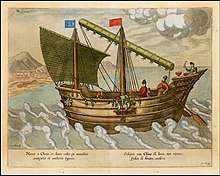
Wang Dayuan's 1349 composition Daoyi Zhilüe Guangzheng Xia ("Description of the Barbarian of the Isles") described the so-called "horse boats" at a place called Gan-mai-li in Southeast Asia. These ships were bigger than normal trading ships, with the sides constructed from multiple planks. The ships uses neither nails or mortar to join them, instead they are using coconut fibre. The ships has two or three decks, with deckhouse over the upper deck. In the lower hold they carried pressed-down frankincense, above them they are carrying several hundred horses. Wang made special mention of these ships because pepper, which is also transported by them, carried to faraway places with large quantity. The normal trading ships carried less than 1/10 of their cargo.[52]
Usually, the main vessel towed behind a smaller "tender" for landing. Data from Marco Polo records made it possible to calculate that the largest ships may have had capacities of 500-800 tons, about the same as Chinese vessels used to trade in the 19th century. The tender itself may have been able to carry about 70 tons.[53]
Niccolò da Conti, in relating his travels in Asia between 1419 and 1444, describes ships much larger than European ships, capable of reaching 2,000 tons in size, with five sails and as many masts. The lower part is constructed with three planks, to withstand the force of the tempests to which they are much exposed. The ships are built in compartments, so that if one part is punctured, the other portion remaining intact to accomplish the voyage.[54]
Fra Mauro in his map explained that one junk rounded the Cape of Good Hope and traveled far into the Atlantic Ocean, in 1420:
About the year of Our Lord 1420 a ship, what is called an Indian zoncho, on a crossing of the Sea of India towards the "Isle of Men and Women", was diverted beyond the "Cape of Diab" (Shown as the Cape of Good Hope on the map), through the "Green Isles" (lit. "isole uerde", Cabo Verde Islands), out into the "Sea of Darkness" (Atlantic Ocean) on a way west and southwest. Nothing but air and water was seen for 40 days and by their reckoning they ran 2,000 miles and fortune deserted them. When the stress of the weather had subsided they made the return to the said "Cape of Diab" in 70 days and drawing near to the shore to supply their wants the sailors saw the egg of a bird called roc, which egg is as big as an amphora.
— Text from Fra Mauro map, 10-A13, [55]
European age of discovery
The Portuguese historian João de Barros (1496–1570) wrote that when a violent storm arose as Albuquerque's fleet entered the vast waters between Sri Lanka and Aceh, a ship commanded by Simão Martinho was sunk, but his entire crew was rescued by Fernão Pires de Andrade and taken aboard his ship. To make up for this loss, the Portuguese captured and commandeered five ships from Gujarat that were sailing between Malacca and Sumatra. The small fleet of Albuquerque engaged an enemy "junk" ship of the Malaccan "Moors" near an island between Lumut and Belawan. According to Barros, they fought against this ship for two days.[56] The enemy crew employed tactics of setting inflammable, oleaginous matter on fire as a means of burning Albuquerque's ships and repelling boarding action,[57] as they employed ramming techniques and close-range volleys of artillery. Although the ship surrendered, the Portuguese gained such an admiration for the junk and its crew that they nicknamed it O Bravo (The Brave Junk). The Portuguese crew pleaded with Fernão Pires to convince Albuquerque that the crew should be spared and viewed vassals of Portugal who were simply unaware of who they were actually fighting. Albuquerque eventually agreed to this.[56]
Passing by Pacem (Samudera Pasai Sultanate) the Portuguese came across two junks, one is from Choromandel, which is destroyed immediately,[58]:62 and the other is from Java, it is larger and faster than their flagship, the Flor do Mar. The Portuguese ordered it to halt but it promptly opened fire on the fleet, after which the Portuguese quickly followed suit. Reported by Gaspar Correia:[59]
"Because the junco started the attack, the Governor approached him with his entire fleet. The Portuguese ships began firing on the junco, but it had no effect at all. Then the junco sailed away .... The Portuguese ships then fired on the junco masts .... and the sails are falling. Because it's so tall, our people dare not board it, and our shots did not spoil it one bit because the junco has four layers of board. Our largest cannon was only able to penetrate no more than two layers ... Seeing that, the Governor ordered his nau (carrack) to move to the side of junco. This ship is Flor de la Mar, the highest Portuguese ship. And while trying to climb the junco, the rear of the ship could barely reach its bridge.[note 5] The junco's crew defended themselves so well that the Portuguese ships were forced to sail away from the ship again. (After two days and two nights of fighting) the Governor decides to break the two rudders at the side of the vessel. Only then did the junco surrender."
— Albuquerque
After realizing that their bombards were mostly ineffective (their cannonballs bounced off the hull of the junk),[59] the Portuguese used another tactic: Grappling for closing in to the junk, then attack in close quarter combat and set fire the junk. The junk's crew surrendered after the fire has been extinguished with great difficulty and at least 40 of the crew killed. Once aboard, the Portuguese found a member of the royal family of Pasai, whom Albuquerque hoped he could exchange for the Portuguese prisoners. The junk is about 600 tons burden, with 300 fighting men on board.[58]:62–64
In January 1513 Paty Onuz (also known as Fatih Yunus or Pati Unus) tried to surprise Malacca with 100 vessels with 5,000 Javanese from Jepara and Palembang. About 30 of those were junks weighing about 350-600 tons (except for Pati Unus' flagship), the rest being smaller boats of pangajava, lancaran, and kelulus types. The junks themselves carried 12,000 men.[14] These vessels carried much Javanese artillery.[note 6] Although defeated, Pati Unus sailed home and beached his warship as a monument of a fight against men he called the bravest in the world, his exploit winning him a few years later the throne of Demak.[60] In a letter to Afonso de Albuquerque, from Cannanore, 22 Feb. 1513, Fernão Pires de Andrade, the Captain of the fleet that routed Pate Unus, says:[24]
"The junk of Pati Unus is the largest seen by men of these parts so far. It carried a thousand fighting men on board, and your Lordship can believe me . . . that it was an amazing thing to see, because the Anunciada near it did not look like a ship at all. We attacked it with bombards, but even the shots of the largest did not pierce it below the water-line, and (the shots of) the esfera (Portuguese large cannon) I had in my ship went in but did not pass through; it had three sheathings, all of which were over a cruzado thick.[note 7] And it certainly was so monstrous that no man had ever seen the like. It took three years to build, as your Lordship may have heard tell in Malacca concerning this Pati Unus, who made this armada to become king of Malacca."
— Fernão Pires de Andrade, Suma Oriental
Castanheda noted that Pati Unus' junk is built with 7 layers of planking, called lapis in Malay, between each layer was put a coating consisting a mixture of bitumen, lime, and oil.[14] Pati Unus was using it as floating fortress to blockading the area around Malacca.[51]
The Portuguese remarked that such large, unwieldy ships were weaknesses. The Portuguese succeeded in repelling the attack using smaller but more maneuverable ships, using boarding tactics and setting fire to the junks.[14] They did not specify the exact size of Pati Unus' junk. Djoko Nugroho's research from Portuguese sources concludes that it has a length of 4-5 times the Flor do Mar (a nau).[3]:307 This would make its size about 144–180 m, with the tonnage between 1600-2000 tons.[3] Other scholars put it as low as 1000 tons, which indicates a length of 70–90 m.[9] Impressed by this kind of ship, Albuquerque hired 60 Javanese carpenters and shipbuilders to from Malacca shipyard and sent them to India, with the hope that these craftsmen will be able to repair Portuguese ships in India. But they never arrived in India, they rebelled and took the Portuguese ship they boarded to Pasai, where they were welcomed extraordinarily.[61] At least 1 jong was sailed to Portugal, to be deployed as coast guard ship at Sacavem under the instruction of king John III.[62][note 8]
Giovanni da Empoli (a Florentine merchant) said that in the land of Java, a junk is no different in its strength than a castle, because it had three and four boards, one above the other, which cannot be harmed with artillery. They sail with their women, children, and family, and everyone has a room to themselves.[63]
Tome Pires in 1515 wrote that the authorities of Canton (Guangzhou) made a law that obliged foreign ships to anchor at an island off-shore. He said that the Chinese made this law about banning ships from Canton for fear of the Javanese and Malays, for it was believed that one of their junks would rout 20 Chinese junks. China had more than a thousand junks, but one ship of 400 tons could depopulate Canton, and this depopulation would bring great loss to China. The Chinese feared that the city would be taken from them, because Canton was one of China's wealthiest city.[24]
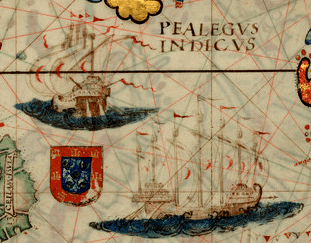 Cropped portion of Indian Ocean in the Miller Atlas, showing 2 jongs, one is a 6-masted ship viewed from aft, the other is a 7-masted ship.
Cropped portion of Indian Ocean in the Miller Atlas, showing 2 jongs, one is a 6-masted ship viewed from aft, the other is a 7-masted ship.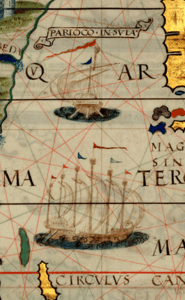 Cropped portion of China Sea, showing six and three-masted jong.
Cropped portion of China Sea, showing six and three-masted jong.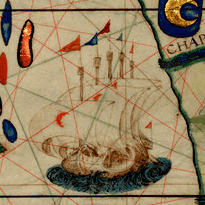 Also showing a portion of China Sea, this one is a 5-masted jong.
Also showing a portion of China Sea, this one is a 5-masted jong.
Lopo Homem-Reineis Atlas (Miller atlas) of 1519 was one of the earliest European map which depict jong. The ships were three to seven masted, with equally sharp end (the presence of stempost and sternpost), and steered using double quarter rudders. However, there are inaccuracies in the depiction. The ships were depicted with high forecastle akin to a carrack. The sail is drawn like a square sail, although the artist may have tried to depict the canted rectangular sail (the tanja sail). The arrow-like structure in the bow may have been an attempt to depict barunastra.[64]
In 1574, queen Kalinyamat of Jepara Sultanate attacked the Portuguese Malacca with 300 vessels under the command of Ki Demat, which included 80 jong of 400 tons burthen and 220 kelulus, although with very little artillery and firearms. As the supplies were dwindling and the air corrupted by disease,[65] Tristão Vaz da Veiga decided to arm a small fleet of a galley and four half-galleys and about 100 soldiers and head out to the River of Malaios, in the middle of the night. Once there, the Portuguese fleet entered the river undetected by the Javanese crews, and resorting to hand-thrown fire bombs set fire to about 30 junks and other crafts, catching the enemy fleet entirely by surprise, and capturing ample supplies amidst the panicking Javanese. After 3 month siege, the Javanese retreated.[66]
François Pyrard of Raval (ca. 1578-1623) mentioned about a wreck of a Sundanese junk in Guradu, south Malé Atoll, Maldives. The ship was carrying all kind of spices and other merchandise from China and Sunda. On board was about 500 men, women, and children, and only 100 was saved during its sinking. The king of Maldives asserted that it was the richest ship conceivable. Pyrard thought it was the largest ship he has ever seen, with the mast being taller and thicker than those of Portuguese carracks, and the top deck was much larger than those of Portugal. The Sundanese queen's parents were the owner of the junk, both were drowned in the sinking. The queen, which was only a child during the sinking, survived.[67]
Decline
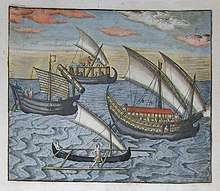
Anthony Reid argues that the failure of jong in battles against smaller and more agile Western ships may convince the Javanese shipbuilders that the large but less agile jong faced too much risk against the European style of naval battle, so the ships they built later were smaller and faster.[68] Since the mid-16th century the maritime forces of the archipelago began to use new types of agile naval vessels that could be equipped with larger cannons: In various attacks on Portuguese Malacca after the defeat of Pati Unus, they no longer used jong, but used lancaran, ghurab and ghali.[13] The jongs that plied the archipelago post-1600s are only averaged at 100 tons burthen,[69] but there are still several of them ranging from 200 to 300 lasts burthen (about 360-400 to 540-600 metric tons burthen)[note 9] in early 1700s.[70]

Production of djongs ended in the 1700s, perhaps because of the decision of Amangkurat I of Mataram Sultanate to destroy ships on coastal cities and close ports to prevent them from rebelling, in 1655.[71] The disappearance of Muria strait denied the shipbuilders around Rembang-Demak access to open water. By 1677, the Batavia Daghregister reported that Mataram is lacking vessels on their own even for necessary use, and very ignorant about sea.[72] When the VOC gained a foothold in Java, they prohibited the locals from building vessels more than 50 tons in tonnage and assigned European supervisors to shipyards.[51] After 1700s, the role of jong has been replaced by European type of ships, namely the bark and brigantine, built at local shipyards of Rembang and Juwana (the former shipbuilding place for jong),[20] such ships may reach 400-600 tons burthen, with the average of 92 lasts (165.6-184 metric tons).[73]
Replica
- A small sized replica is moored along the Marine March of Resorts World Sentosa, Singapore.[74]
In popular culture
- Jong is an Indonesian unique unit in Sid Meier's Civilization VI video game. However, the model used in-game closely resembling Borobudur ship than actual jong.
See also
- List of longest wooden ships
- Ghurab, another large trading ship of Nusantara
- Chinese treasure ship
- Junk (ship)
- Borobudur ship
- Atakebune
Notes
- The tonnage used in this page is DWT or deadweight tonnage, a measure of how much a ship can carry.
- Tanja sails, in the early European reports, are called lateen sail. Also, this type of sail may looked like triangular sail when sighted from afar.
- Some scholars believe this place is actually Kalimantan.
- Might be a mistranslation. It may refer to the height of the ship's hull, from the keel to the open deck.
- Bridge is the opening on the side of the ship for loading cargo, located lower than the upper deck.
- According to Horst H. Liebner, most of the cannons were swivel gun, most likely of cetbang or rentaka type, a type of small and medium sized cannon mounted on gunwale. Larger fixed cannon of Malay ships usually mounted on the forward facing apilan (gunshield).
- A kind of Portuguese coin with a diameter of 3.8 cm.
- From a letter from king João III to Conde da Castanheira, dated 22 August 1536: "Pareceo me bem mandardes a Sacavem pelo galleam Trimdade e pelo junco" (It seems to me that you did right in ordering the deployment of the galleon Trimdade and the jong, which were at Sacavem).
- A last was originally unit of freight volume, subsequently a unit of weight, varying according to the nature of the freight, an equalling roughly to between 1.8 and 2 metric tons.
References
- Illustrated Oxford Dictionary. London: DK. 1998.
- Cartas de Afonso de Albuquerque, Volume 1, p. 64, April 1, 1512
- Nugroho, Irawan Djoko (2011). Majapahit Peradaban Maritim. Suluh Nuswantara Bakti. ISBN 9786029346008.
- Reid, Anthony (2012). Anthony Reid and the Study of the Southeast Asian Past. Singapore: Institute of Southeast Asian Studies. ISBN 978-9814311960.
- Collins Compact Dictionary. HarperCollins. 2002. p. 483. ISBN 0-00-710984-9.
- Junk, Online Etymology Dictionary
- Pelliot, P. (1933). Les grands voyages maritimes chinois au début du XVe siècle. T'oung Pao, 30(3/5), second series, 237-452. Retrieved from http://www.jstor.org/stable/4527050
- Mahdi, Waruno (2007). Malay Words and Malay Things: Lexical Souvenirs from an Exotic Archipelago in German Publications Before 1700. Otto Harrassowitz Verlag. ISBN 9783447054928.
- Manguin, Pierre-Yves (1993). "Trading Ships of the South China Sea. Shipbuilding Techniques and Their Role in the History of the Development of Asian Trade Networks". Journal of the Economic and Social History of the Orient: 253–280.
- Zoetmulder, P. J. (1982). Old Javanese-English dictionary. The Hague: Martinus Nijhoff. ISBN 9024761786.
- Reid, Anthony (2000). Charting the Shape of Early Modern Southeast Asia. Silkworm Books. ISBN 9747551063.
- "JONQUE : Etymologie de JONQUE". www.cnrtl.fr (in French). Retrieved 2018-03-30.
- Manguin, Pierre-Yves. (1993). 'The Vanishing Jong: Insular Southeast Asian Fleets in Trade and War (Fifteenth to Seventeenth Centuries)', in Anthony Reid (ed.), Southeast Asia in the Early Modern Era (Ithaca: Cornell University Press), 197-213.
- Crawfurd, John (1856). A Descriptive Dictionary of the Indian Islands and Adjacent Countries. Bradbury and Evans.
- Pramono, Djoko (2005). Budaya bahari. Gramedia Pustaka Utama. p. 112. ISBN 9789792213515.
- Jones, Russel (2007). Loan-Words in Indonesian and Malay. Yayasan Pustaka Obor Indonesia. p. 51.
- Shaffer, Lynda Norene (1996). Maritime Southeast Asia to 1500. M.E. Sharpe.
- Johnstone, Paul (1980). The Seacraft of Prehistory. Cambridge: Harvard University Press. ISBN 978-0674795952.
- Jones, John Winter (1863). The travels of Ludovico di Varthema in Egypt, Syria, Arabia Deserta and Arabia Felix, in Persia, India, and Ethiopia, A.D. 1503 to 1508. Hakluyt Society.
- Liebner, Horst H. (2002). Perahu-Perahu Tradisional Nusantara. Jakarta.
- "Majapahit-era Technologies". Nusantara Review. 2018-10-02. Retrieved 2020-06-11.
- Couto, Diogo do (1645). Da Asia: Nine decades. Lisbon: Regia Officina Typografica, 1778-88. Reprint, Lisbon, 1974.
- Barbosa, Duarte (1866). A Description of the Coasts of East Africa and Malabar in the Beginning of the Sixteenth Century. The Hakluyt Society.
- Pires, Tome (1944). The Suma oriental of Tomé Pires : an account of the East, from the Red Sea to Japan, written in Malacca and India in 1512-1515 ; and, the book of Francisco Rodrigues, rutter of a voyage in the Red Sea, nautical rules, almanack and maps, written and drawn in the East before 1515. London: The Hakluyt Society. ISBN 9784000085052.
- Manguin, Pierre-Yves (September 1980). "The Southeast Asian Ship: An Historical Approach". Journal of Southeast Asian Studies. 11 (2): 266–276. doi:10.1017/S002246340000446X. JSTOR 20070359.
- "Cannon | Indonesia (Java) | Majapahit period (1296–1520) | The Met". The Metropolitan Museum of Art, i.e. The Met Museum. Retrieved 6 August 2017.
- Tarling, Nicholas (1999). The Cambridge History of Southeast Asia. Cambridge: Cambridge University Press. ISBN 9780521663700.
- Rouffaer, G.P. (1915). De eerste schipvaart der Nederlanders naar Oost-Indië onder Cornelis de Houtman. Den Haag: 'S-Gravenhage M. Nijhoff.
- Monleón, Rafael (1890). Historia gráfica de la navegación y de las construcciones navales en todos los tiempos y en todos los países.
- Historia das ilhas de Maluco, in A. B. de Sa, Documentacao para a Historia das missoes do Padroado portugues do Oriente - Insulindia, Lisboa, 1954-58, vol. III, p. 322.
- Casparis, Johannes G. de (1956). Prasasti Indonesia: Selected Inscriptions from the 7th to the 9th Century A.D. Bandung: Masa Baru.
- Agius, Dionisius A. (2007). Classic Ships of Islam: From Mesopotamia to the Indian Ocean. Brill Academic Pub. ISBN 9004277854.
- Coedès, George (1968). The Indianized States of South-East Asia. University of Hawaii Press. ISBN 9780824803681.
- Dick-Read, Robert (2005). The Phantom Voyagers: Evidence of Indonesian Settlement in Africa in Ancient Times. Thurlton.
- Dick-Read, Robert (July 2006). "Indonesia and Africa: questioning the origins of some of Africa's most famous icons". The Journal for Transdisciplinary Research in Southern Africa. 2: 23–45.
- Christie, Anthony (1957). "An Obscure Passage from the "Periplus: ΚΟΛΑΝΔΙΟϕΩΝΤΑ ΤΑ ΜΕΓΙΣΤΑ"". Bulletin of the School of Oriental and African Studies, University of London. 19: 345–353 – via JSTOR.
- Strange Things of the South, Wan Chen, from Robert Temple
- Rafiek, M. (December 2011). "Ships and Boats in the Story of King Banjar: Semantic Studies". Borneo Research Journal. 5: 187–200.
- Micheal Jacq-Hergoualc'h (2002). The Malay Peninsula: Crossroads of the Maritime Silk-Road (100 BC-1300 AD). BRILL. pp. 51–52.
- Groeneveldt, W.P. (1877). Notes on the Malay Archipelago and Malacca, Compiled from Chinese Sources. Batavia: Transactions of the Batavian Society of Arts and Science.
- Needham, Volume 4, Part 3, 464.
- Yule, Sir Henry (1866). Cathay and the way thither: Being a Collection of Medieval Notices of China vol. 1. London: The Hakluyt Society.
- Chronicle of the Kings of Pasai, 3: 98: After that, he is tasked by His Majesty to ready all the equipment and all weapons of war to come to that country of Pasai, about four hundred large jongs and other than that much more of malangbang and kelulus.
- Sejarah Melayu, 10.4:77: then His Majesty immediately ordered to equip three hundred jong, other than that kelulus, pelang, jongkong in uncountable numbers.
- Cho, Hung-guk (2009). Han'guk-gwa Dongnam Asia-ui Gyoryusa 한국과 동남아시아의 교류사 [History of Exchanges between Korea and Southeast Asia]. Seoul: Sonamu.
- Tirmizi (November 2016). "Budaya Bahari dan Dinamika Kehidupan Bangsa dalam Perspektif Sejarah". Prosiding Konferensi Sejarah Nasional. 4: 93–120.
- Setiawan, Hawe. Bujangga Manik dan Studi Sunda (PDF).
- Kitab Bujangga Manik, verse 995-999: Parahu patina ageung, jong kapal buka dalapan, pa(n)jangna salawe deupa. [This boat was quite large, a jong of 8 depa wide, the length is 25 depa.]
- Solution, Kataku co id by Magma IT. "Kapal Terbesar Dunia Yang Dimiliki Kerajaan Majapahit". bapakita.id - Selalu Ada Kata. Retrieved 2020-08-07.
- Berg, C. C., 1927, Kidung Sunda. Inleiding, tekst, vertaling en aanteekeningen, BKI LXXXIII : 1-161.
- Lombard, Denys (1990). Le carrefour javanais. Essai d'histoire globale (The Javanese Crossroads: Towards a Global History) vol. 2. Paris: Éditions de l'École des Hautes Études en Sciences Sociales.
- Kwee, H. K. (1997). Dao Yi Zhi Lue as a maritime traders’ guidebook. Unpublished honour’s thesis, National University of Singapore.
- Wake, Christopher (December 1997). "The Great Ocean-going Ships of Southern China in the Age of Chinese Maritime Voyaging to India, Twelfth to Fifteenth Centuries". International Journal of Maritime History.
- R. H. Major, ed. (1857), "The travels of Niccolo Conti", India in the Fifteenth Century, Hakluyt Society, p. 27 Discussed in Needham, Science and Civilisation in China, p. 452
- Text from Fra Mauro map, 10-A13, original Italian: "Circa hi ani del Signor 1420 una naue ouer çoncho de india discorse per una trauersa per el mar de india a la uia de le isole de hi homeni e de le done de fuora dal cauo de diab e tra le isole uerde e le oscuritade a la uia de ponente e de garbin per 40 çornade, non trouando mai altro che aiere e aqua, e per suo arbitrio iscorse 2000 mia e declinata la fortuna i fece suo retorno in çorni 70 fina al sopradito cauo de diab. E acostandose la naue a le riue per suo bisogno, i marinari uedeno uno ouo de uno oselo nominato chrocho, el qual ouo era de la grandeça de una bota d'anfora."
- Dion, Mark. "Sumatra through Portuguese Eyes: Excerpts from João de Barros' 'Decadas da Asia',". Indonesia (Volume 9, 1970): 128–162.
- Marsden, William (1811). The history of Sumatra, containing an account of the government, laws, customs, and manners of the native inhabitants. Longman, Hurst, Rees, Orme, and Brown.
- Albuquerque, Afonso de (1875). The Commentaries of the Great Afonso Dalboquerque, Second Viceroy of India, translated from the Portuguese edition of 1774. London: The Hakluyt society.
- Correia, Gaspar (1602). Lendas da Índia vol. 2. p. 219.
- Winstedt. A History of Malay. p. 70.
- Reid, Anthony (1988). Southeast Asia in the Age of Commerce, 1450-1680: The lands below the winds, Volume 1. Yale University Press. ISBN 9780300039214.
- Schottenhammer, Angela (2019). Early Global Interconnectivity across the Indian Ocean World, Volume II. Switzerland: Palgrave Macmillan. p. 173. ISBN 978-3-319-97801-7.
- da Empoli, Giovanni (2010). Lettera di Giovanni da Empoli. California: Istituto Italiano per il Medio ed Estremo Oriente.
- Siebold, Jim (2016). The Atlas Miller. p. 15.
- Marsden, William (2012). The History of Sumatra: Containing an Account of the Government, Laws, Customs, and Manners of the Native Inhabitants. Cambridge University Press. p. 431.
- Monteiro, Saturnino (2011). Portuguese Sea Battles, Volume III - From Brazil to Japan, 1539-1579.
- Pyrard, François (1887). The voyage of François Pyrard of Laval to the East Indies, the Maldives, the Moluccas and Brazil. London: Hakluyt Society. p. 258.
- Reid, Anthony (1992): 'The Rise and Fall of Sino-Javanese Shipping', in V.J.H. Houben, H.M.J. Maier, and Willem van der Molen (eds.), Looking in Odd Mirrors (Leiden: Vakgroep Talen en Culturen van Zuidoost-Azië en Oceanië), 177-211.
- Liebner, Horst H. (2016). Beberapa Catatan Akan Sejarah Pembuatan Perahu Dan Pelayaran Nusantara. Jakarta: Indonesian Ministry of Education and Culture.
- Mahdi, Waruno (2007). Malay Words and Malay Things: Lexical Souvenirs from an Exotic Archipelago in German Publications Before 1700. Otto Harrassowitz Verlag. ISBN 9783447054928.
- Ricklefs, M.C. (2008). A History of Modern Indonesia Since C.1200. Macmillan International Higher Education. ISBN 9781137052018.
- Schrieke, B.J.O. 1955-1957. Indonesian Sociological Studies. 2 vols.The Hague: Van Hoeve. Schulte Nordholt, H. 1980. "Macht, mensen en middelen: patronenvan dynamiek in de Balische politiek." M.A. thesis, Vrije Universiteit.
- Lee, Kam Hing (1986): 'The Shipping Lists of Dutch Melaka: A Source for the Study of Coastal Trade and Shipping in the Malay Peninsula During the 17th and 18th Centuries', in Mohd. Y. Hashim (ed.), Ships and Sunken Treasure (Kuala Lumpur: Persatuan Muzium Malaysia), 53-76.
- "I ship it! Historic Ship Harbour at RWS". S.E.A. Aquarium at Resorts World Sentosa. 2014-06-04. Archived from the original on 2018-07-31. Retrieved 2018-08-14.
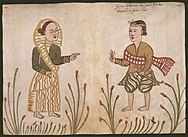
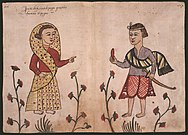
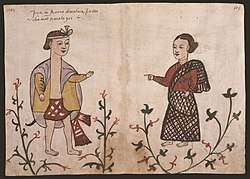


.jpg)